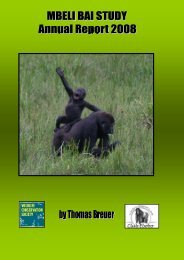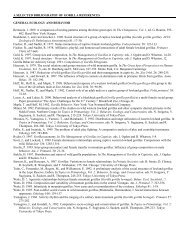First Prosimian Husbandry Workshop 2009 - Cleveland Metroparks ...
First Prosimian Husbandry Workshop 2009 - Cleveland Metroparks ...
First Prosimian Husbandry Workshop 2009 - Cleveland Metroparks ...
You also want an ePaper? Increase the reach of your titles
YUMPU automatically turns print PDFs into web optimized ePapers that Google loves.
Pedigree Reconstruction Project<br />
Need to collect blood, tissue or hair samples from all living or dead ring-tail lemurs in the SSP. Over<br />
the past four years we have verified samples that have been submitted.<br />
<strong>Prosimian</strong> TAG<br />
The mission of the <strong>Prosimian</strong> TAG is to complement, promote and participate in the efforts to<br />
conserve prosimians in nature and to advance the highest levels of animal welfare. The main<br />
responsibility of the TAG is the regional collection plan. <strong>First</strong>, we look at the conservation status of all<br />
prosimians via the IUCN ratings. As a TAG, you must do a space assessment for your institution. The<br />
TAG created a flowchart to decide how to select that taxa to be housed in North American institutions.<br />
Within the TAG, umbrella SSPs were created: nocturnal, eulemur, ring-tail, ruffed and propithecus.<br />
There are other programs that the populations can be managed under such as a PMP (population<br />
management plan) or a DERP (display/education/research populations). There are also phase-out<br />
populations or species that are not recommended. One phase out population is the bamboo lemur.<br />
Hybrids are SSP animals, but must be assessed to see which are viable to work with.<br />
Ex. Eulemur: The current population is 246 and the target population is 215. Certain species are<br />
listedas breeding or exhibit only.<br />
We are also working with Europe and Australia on management plans. You can also find many<br />
documents within the prosimian taxon advisory group.<br />
Comment (Chris Kuhar.): If a species is exhibit only, the species is still managed by the SSP and are<br />
part of the population even if they are going to be phased out.<br />
Moderator (Lynne Villers): We may still have a need for that animal within the SSP.<br />
Question: Do SSPs ever recommend sterilization?<br />
Moderator (Lynne Villers): Yes, but it is not taken lightly. If an institution is considering this, they<br />
should talk to the SSP coordinator.<br />
Question (Dawn Stone): Why are bamboo lemurs being phased out, because of lack of numbers? Can<br />
we get some from Europe?<br />
Moderator (Lynne Villers): Duke is looking into this, but the current numbers are passing away. At<br />
this point, we will let Europe work on this and see what happens. The TAG is open to discussions, but<br />
also don’t want to be overly flexible.<br />
Comment (Ingrid Porton): Europe is having trouble finding enough space for their allotrensis. We are<br />
working on an exchange between Ivo Louin in Madagascar and Europe. Sinus is the species of<br />
Hapalemur if we do want to bring these animals in.<br />
Comment (Chris Kuhar): It is a lot more complicated than working with Europe. We had planned to<br />
send Europe rubriventer, but the individuals were old and they would prefer prime breeding animals.<br />
Question (Tad Schoffner): Are institutions more willing to devote more space to prosimians?<br />
Answer (Chris Kuhar): Everyone says they want more individuals, but none are adding groups.<br />
Everyone wants huge groups which is not practical. Omaha is the only institution recently that has<br />
built for prosimians.<br />
Comment (Ingrid Porton): There is no difference in space. Institutions need to have space to hold the<br />
offspring.<br />
Comment (Chris Kuhar): This is why we need to phase out species with small numbers because we<br />
need the space for breeding SSP species.<br />
41




